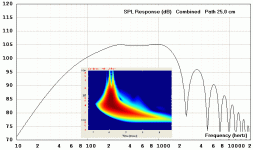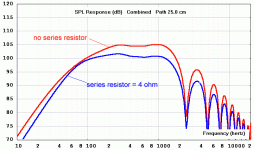Hello,
The 500Hz is a bit small for that driver but anyway, let's study the problem.
I guess that you don't use any no throat chamber. If you choose a closed backchamber, a volume from 2 to 4 liters seems OK (after simulation using Hornresp).
According to Hornresp it seems that good results may also be obtained without backchamber.
Best regards from Paris, France
Jean-Michel Le Cléac'h
The 500Hz is a bit small for that driver but anyway, let's study the problem.
I guess that you don't use any no throat chamber. If you choose a closed backchamber, a volume from 2 to 4 liters seems OK (after simulation using Hornresp).
According to Hornresp it seems that good results may also be obtained without backchamber.
Best regards from Paris, France
Jean-Michel Le Cléac'h
Ok... so this is an interesting case, but from another point of view.
This driver seems to exhibit flat response across a very wide range - definitely from below the proposed 500 Hz. point and above.
My understanding is that a horn loaded driver will in essence be given an EQ that rises looking from a high frequency down to the cutoff frequency of the horn. In other words, more "boost" as one goes down. At higher freqs, there is little "gain" from the horn, in effect acting more or less like a direct radiator...
Is this incorrect, and what is the predicted response using Hornresp for this flat driver loaded into a horn??
_-_-bear
This driver seems to exhibit flat response across a very wide range - definitely from below the proposed 500 Hz. point and above.
My understanding is that a horn loaded driver will in essence be given an EQ that rises looking from a high frequency down to the cutoff frequency of the horn. In other words, more "boost" as one goes down. At higher freqs, there is little "gain" from the horn, in effect acting more or less like a direct radiator...
Is this incorrect, and what is the predicted response using Hornresp for this flat driver loaded into a horn??
_-_-bear
Hello Bear,
It is very difficult to predict the on axis high frequency response of an electrodynamical loudspeaker(wahtever the load) either with Hornresp, Winisd...
Every time the HF is mass limited. In the real world most often we can see an HF extension far over the F-3dB predicted. THis is for a part due to the fact that a membrane is not a rigid flat piston, neither geometrically, neither mechanically.
At HF the radiation is like it was emitted by a small central part of the driver isolated from the outer part.
I would say that in the example of the 10cm Scan-Speak loudspeaker mounted on the horn we cannot rely on any modelisation in order to predict the limit and the shape in the high frequency of the loudspeaker.
Now the lowest part of the frequency response is more easily modelized and you'll see what Hornresp predict with a Le Cléac'h horn having Fc = 500Hz loading the 10cm scan Speak Loudspeaker without using any backchamber (see attached file).
Best regards from Paris, France
Jean-Michel Le Cléac'h
It is very difficult to predict the on axis high frequency response of an electrodynamical loudspeaker(wahtever the load) either with Hornresp, Winisd...
Every time the HF is mass limited. In the real world most often we can see an HF extension far over the F-3dB predicted. THis is for a part due to the fact that a membrane is not a rigid flat piston, neither geometrically, neither mechanically.
At HF the radiation is like it was emitted by a small central part of the driver isolated from the outer part.
I would say that in the example of the 10cm Scan-Speak loudspeaker mounted on the horn we cannot rely on any modelisation in order to predict the limit and the shape in the high frequency of the loudspeaker.
Now the lowest part of the frequency response is more easily modelized and you'll see what Hornresp predict with a Le Cléac'h horn having Fc = 500Hz loading the 10cm scan Speak Loudspeaker without using any backchamber (see attached file).
Best regards from Paris, France
Jean-Michel Le Cléac'h
Attachments
Hmmm... not what I would have expected.
I am presuming that there is no "compression" at the driver... would compression change how it works frequency response wise?? ...so, I am surprised that there is no boost due to the loading of the horn and that the response remains flat.
Any comment on the comb filter looking HF bounces? Due to the radiation from the small central part and reflections at the throat?
Again, I am unclear on why the response of this driver would be flat with a horn loading, and flat with an IEC baffle as well - in this the lower range...
(btw, can't quite make out what the small inset color graph is showing)
regards,
_-_-bear
I am presuming that there is no "compression" at the driver... would compression change how it works frequency response wise?? ...so, I am surprised that there is no boost due to the loading of the horn and that the response remains flat.
Any comment on the comb filter looking HF bounces? Due to the radiation from the small central part and reflections at the throat?
Again, I am unclear on why the response of this driver would be flat with a horn loading, and flat with an IEC baffle as well - in this the lower range...
(btw, can't quite make out what the small inset color graph is showing)
regards,
_-_-bear
Hello Bear,
The Hornresp simulation has been done without throat chamber (= compression chamber sensus stricto).
Hornresp cannot gives both axial response and combined response (front wave + rera wave). The shown response was for a combined response and thus is a total power response radiated into 2pi.
As for the lower frequency response we can even do better using some series resitor (4 ohms is sufficient here). See attached graph.
The Qts of that loudspeaker is a bit high for a loudspeaker used with a horn, but as simulated the frequency response allows a use as a low mid channel.
The colored graph is what is called Impulse Spectrogram in Honresp. As written in Hornresp help:
Impulse Spectrogram: diplays the impulse spectral density, or normalised amplitude in decibels as a fonction of frequency, versus time in milliseconds.
(BTW, I am the author of that spectrogram module).
Best regards from Paris, France
Jean-Michel Le Cléac'h
P.S.: I'll be off line until August 20th.
The Hornresp simulation has been done without throat chamber (= compression chamber sensus stricto).
Hornresp cannot gives both axial response and combined response (front wave + rera wave). The shown response was for a combined response and thus is a total power response radiated into 2pi.
As for the lower frequency response we can even do better using some series resitor (4 ohms is sufficient here). See attached graph.
The Qts of that loudspeaker is a bit high for a loudspeaker used with a horn, but as simulated the frequency response allows a use as a low mid channel.
The colored graph is what is called Impulse Spectrogram in Honresp. As written in Hornresp help:
Impulse Spectrogram: diplays the impulse spectral density, or normalised amplitude in decibels as a fonction of frequency, versus time in milliseconds.
(BTW, I am the author of that spectrogram module).
Best regards from Paris, France
Jean-Michel Le Cléac'h
P.S.: I'll be off line until August 20th.
Hmmm... not what I would have expected.
I am presuming that there is no "compression" at the driver... would compression change how it works frequency response wise?? ...so, I am surprised that there is no boost due to the loading of the horn and that the response remains flat.
Any comment on the comb filter looking HF bounces? Due to the radiation from the small central part and reflections at the throat?
Again, I am unclear on why the response of this driver would be flat with a horn loading, and flat with an IEC baffle as well - in this the lower range...
(btw, can't quite make out what the small inset color graph is showing)
regards,
_-_-bear
Attachments
...The 500Hz is a bit small for that driver but anyway...
Could you elaborate a bit please? 🙂
Think I'll go with 1/2 a litre sealed, and aperiodic load it to 2 litres.
Again, I am unclear on why the response of this driver would be flat with a horn loading, and flat with an IEC baffle as well - in this the lower range...
It wont 🙂 You have do deal with that in the crossover.
- Status
- Not open for further replies.
- Home
- Loudspeakers
- Multi-Way
- Backchamber in a JMLC horn

